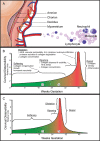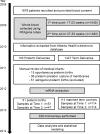Maternal Whole Blood Gene Expression at 18 and 28 Weeks of Gestation Associated with Spontaneous Preterm Birth in Asymptomatic Women
- PMID: 27333071
- PMCID: PMC4917227
- DOI: 10.1371/journal.pone.0155191
Maternal Whole Blood Gene Expression at 18 and 28 Weeks of Gestation Associated with Spontaneous Preterm Birth in Asymptomatic Women
Abstract
The heterogeneity of spontaneous preterm birth (SPTB) requires an interdisciplinary approach to determine potential predictive risk factors of early delivery. The aim of this study was to investigate maternal whole blood gene expression profiles associated with spontaneous preterm birth (SPTB, <37 weeks) in asymptomatic pregnant women. The study population was a matched subgroup of women (51 SPTBs, 114 term delivery controls) who participated in the All Our Babies community based cohort in Calgary (n = 1878). Maternal blood at 17-23 (sampling time point 1, T1) and 27-33 weeks of gestation (T2) were collected. Total RNA was extracted and microarray was performed on 326 samples (165 women). Univariate analyses determined significant clinical factors and differential gene expression associated with SPTB. Thirteen genes were validated using qRT-PCR. Three multivariate logistic models were constructed to identify gene expression at T1 (Model A), T2 (Model B), and gene expression fold change from T1 to T2 (Model C) associated with SPTB. All models were adjusted for clinical factors. Model C can predict SPTB with 65% sensitivity and 88% specificity in asymptomatic women after adjusting for history of abortion and anaemia (occurring before T2). Clinical data enhanced the sensitivity of the Models to predict SPTB. In conclusion, clinical factors and whole blood gene expression are associated with SPTB in asymptomatic women. An effective screening tool for SPTB during pregnancy would enable targeted preventive approaches and personalised antenatal care.
Conflict of interest statement
Figures



Similar articles
-
Whole blood gene expression profile associated with spontaneous preterm birth in women with threatened preterm labor.PLoS One. 2014 May 14;9(5):e96901. doi: 10.1371/journal.pone.0096901. eCollection 2014. PLoS One. 2014. PMID: 24828675 Free PMC article.
-
Early pregnancy prediction of spontaneous preterm birth before 32 completed weeks of pregnancy using plasma RNA: transcriptome discovery and initial validation of an RNA panel of markers.BJOG. 2021 Oct;128(11):1870-1880. doi: 10.1111/1471-0528.16736. Epub 2021 May 27. BJOG. 2021. PMID: 33969600 Free PMC article.
-
Efficacy of serum procalcitonin to predict spontaneous preterm birth in women with threatened preterm labour: a prospective observational study.BMC Pregnancy Childbirth. 2018 Mar 7;18(1):65. doi: 10.1186/s12884-018-1696-2. BMC Pregnancy Childbirth. 2018. PMID: 29514604 Free PMC article.
-
Risk of spontaneous preterm birth in singleton pregnancies conceived after IVF/ICSI treatment: meta-analysis of cohort studies.Ultrasound Obstet Gynecol. 2018 Jan;51(1):43-53. doi: 10.1002/uog.18930. Ultrasound Obstet Gynecol. 2018. PMID: 29114987 Review.
-
[Prevention of spontaneous preterm birth (excluding preterm premature rupture of membranes): Guidelines for clinical practice - Text of the Guidelines (short text)].J Gynecol Obstet Biol Reprod (Paris). 2016 Dec;45(10):1446-1456. doi: 10.1016/j.jgyn.2016.09.011. Epub 2016 Nov 9. J Gynecol Obstet Biol Reprod (Paris). 2016. PMID: 27836377 Review. French.
Cited by
-
Quality assessment of RNA in long-term storage: The All Our Families biorepository.PLoS One. 2020 Dec 1;15(12):e0242404. doi: 10.1371/journal.pone.0242404. eCollection 2020. PLoS One. 2020. PMID: 33259520 Free PMC article.
-
Recent Advances and Challenges in the Early Diagnosis and Treatment of Preterm Labor.Bioengineering (Basel). 2024 Feb 6;11(2):161. doi: 10.3390/bioengineering11020161. Bioengineering (Basel). 2024. PMID: 38391647 Free PMC article. Review.
-
Single cell transcriptional signatures of the human placenta in term and preterm parturition.Elife. 2019 Dec 12;8:e52004. doi: 10.7554/eLife.52004. Elife. 2019. PMID: 31829938 Free PMC article.
-
The Role of Genetics in Preterm Birth.Reprod Sci. 2023 Dec;30(12):3410-3427. doi: 10.1007/s43032-023-01287-9. Epub 2023 Jul 14. Reprod Sci. 2023. PMID: 37450251 Free PMC article. Review.
-
Recent advances in the prevention of preterm birth.F1000Res. 2017 Jul 18;6:F1000 Faculty Rev-1139. doi: 10.12688/f1000research.11385.1. eCollection 2017. F1000Res. 2017. PMID: 28781747 Free PMC article. Review.
References
-
- Johansson AM, Domellof E, Ronnqvist L. Long-term influences of a preterm birth on movement organization and side specialization in children at 4–8 years of age. Dev Psychobiol. 2014. - PubMed
-
- Institute of Medicine. Preterm birth. Causes, consequences, and prevention Behrman RE, Butler AS, editors. Washington DC: National Academies Press; 2007. - PubMed
MeSH terms
LinkOut - more resources
Full Text Sources
Other Literature Sources
Molecular Biology Databases

